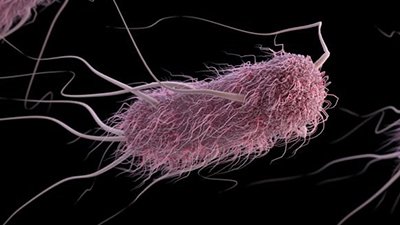Just Endosymbiosis
This ciliate gets the most from its veggies.
News Source
- New Scientist: ““Zoologger: Unique Life Form Is Half Plant, Half Animal”
A newly discovered species of unicellular ciliate is being touted by New Scientist as the poster-child of endosymbiotic theory. Mesodinium chamaeleon was discovered in Nivå Bay in Denmark and characterized by Øjvind Moestrup’s Copenhagen team. The single-celled organism engulfs cryptomonad algae, encloses them in vacuoles, and presumably benefits from the sugar these photosynthetic algae produce. Eventually the algae are digested.
While harboring the live algae, M. chamaeleon seems to maintain a mutually beneficial symbiotic relationship with its algae. The algae may benefit from the protection afforded by the ciliate, at least until the ciliate digests them.
Endosymbiosis is merely symbiosis in which a microorganism lives inside its host. These organisms appear to have that sort of relationship, although Moestrup’s team could not keep the ciliate alive very long or get it to reproduce. The ciliate had “food vacuoles with recently ingested prey, some vacuoles with prey ingested some time ago, as demonstrated by the close-fitting membrane around the prey, and vacuoles with remains of food. All ingested cells had an intact nucleus.”1 The team could not determine the ultimate “fate of the chloroplasts”2 but think the algae remained photosynthetically active for a time and then got digested.
Some Mesodinium species immediately digest the algae they engulf, and others keep their algae in food vacuoles indefinitely. Although authors of the paper published in The Journal of Eukaryotic Microbiology do write that M. chamaeleon “appears to occupy an intermediate position” based on this behavior,3 they do not claim it is an evolutionary intermediate. The New Scientist, however, goes further.
The New Scientist journalist asserts, “M. chamaeleon may offer a snapshot of how endosymbiosis developed: the organism is still on the road from simply eating other cells to keeping them alive within itself.”4 Whereas ordinary endosymbiosis involves only a symbiotic relationship with a particular “geography,” the “endosymbiotic theory” popularized by Dr. Lynn Margulis suggests that eukaryotic cells evolved by engulfing bacteria and cyanobacteria and turning them into mitochondria and chloroplasts. As described by New Scientist, “Some 2 billion years ago, a single cell swallowed a bacterium and used it as an energy source. The descendants of the enslaved bacterium eventually became the mitochondria that now power all complex cells, including ours. Without endosymbiosis, there wouldn’t be any multicellular life.”5
“Endosymbiotic theory” has a number of problems. For instance, the “proto-mitochondria/chloroplast” would have to establish a complex interdependence with the cell’s nucleus by transferring genes to the nucleus and evolving a way to transport the proteins back to the new organelle. Yet no part of this complex system could evolve and be selected for survival until all the parts were in place. Furthermore, no transitional forms have ever been found.
Moestrup’s team noted some algae were alive with intact nuclei while others were digested but never suggested the algae’s chloroplasts were becoming ciliate organelles. There is nothing in their paper to support the New Scientist’s assertion that the algae are anything other than ordinary symbionts and then prey.
God created all kinds of living things fully functional during Creation Week about 6,000 years ago. Living things—whether plants, animals, or microorganisms—vary within their kinds but only reproduce after their kinds. Microorganisms fulfill many important roles in our world, and they are frequently found as endosymbionts. For instance, we harbor beneficial bacteria in our colons. Mesodinea are functioning as they were designed and possess the capacity for various degrees of endosymbiosis. Nothing in the study even suggests they are “on the road” to becoming a new kind of organism or incorporating algae parts as their own organelles.
Further Reading
- A Review of Mitoribosome Structure and Function Does not Support the Serial Endosymbiotic Theory
- Georgia Purdom’s blog: Evolutionist challenges mechanisms of natural selection and mutation
- More Microfossils
- The Origin of Microorganisms
- Get Answers: Origin of life
For More Information: Get Answers
Remember, if you see a news story that might merit some attention, let us know about it! (Note: if the story originates from the Associated Press, FOX News, MSNBC, the New York Times, or another major national media outlet, we will most likely have already heard about it.) And thanks to all of our readers who have submitted great news tips to us. If you didn’t catch all the latest News to Know, why not take a look to see what you’ve missed?
(Please note that links will take you directly to the source. Answers in Genesis is not responsible for content on the websites to which we refer. For more information, please see our Privacy Policy.)
Footnotes
- Øjvind Moestrup, Lydia Garcia-Cuetos, Per Juel Hansen, and Tom Fenchel, “Studies on the Genus Mesodinium I: Ultrastructure and Description of Mesodinium chamaeleon n. sp., a Benthic Marine Species with Green or Red Chloroplasts,” The Journal of Eukaryotic Microbiology 59, no. 1 (2012): 20–39, doi: 10.1111/j.1550-7408.2011.00593.x
- Ibid.
- Ibid.
- Michael Marshall, “Zoologger: Unique Life Form Is Half Plant, Half Animal,” New Scientist, January 13, 2012, https://www.newscientist.com/article/dn21353-zoologger-unique-life-form-is-half-plant-half-animal/.
- Ibid.
Recommended Resources

Answers in Genesis is an apologetics ministry, dedicated to helping Christians defend their faith and proclaim the good news of Jesus Christ.
- Customer Service 800.778.3390
- Available Monday–Friday | 9 AM–5 PM ET
- © 2025 Answers in Genesis






